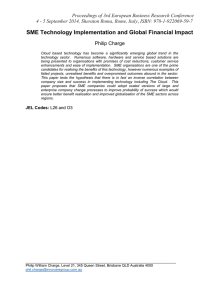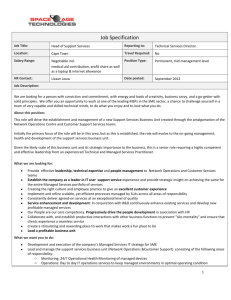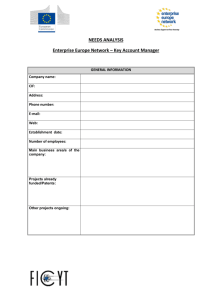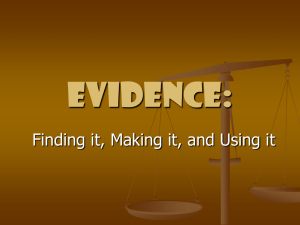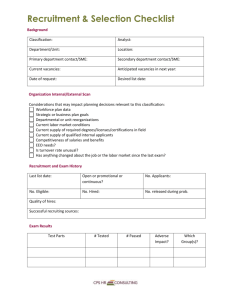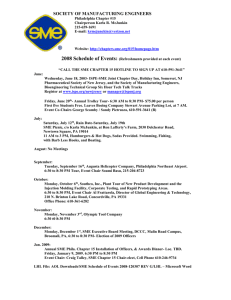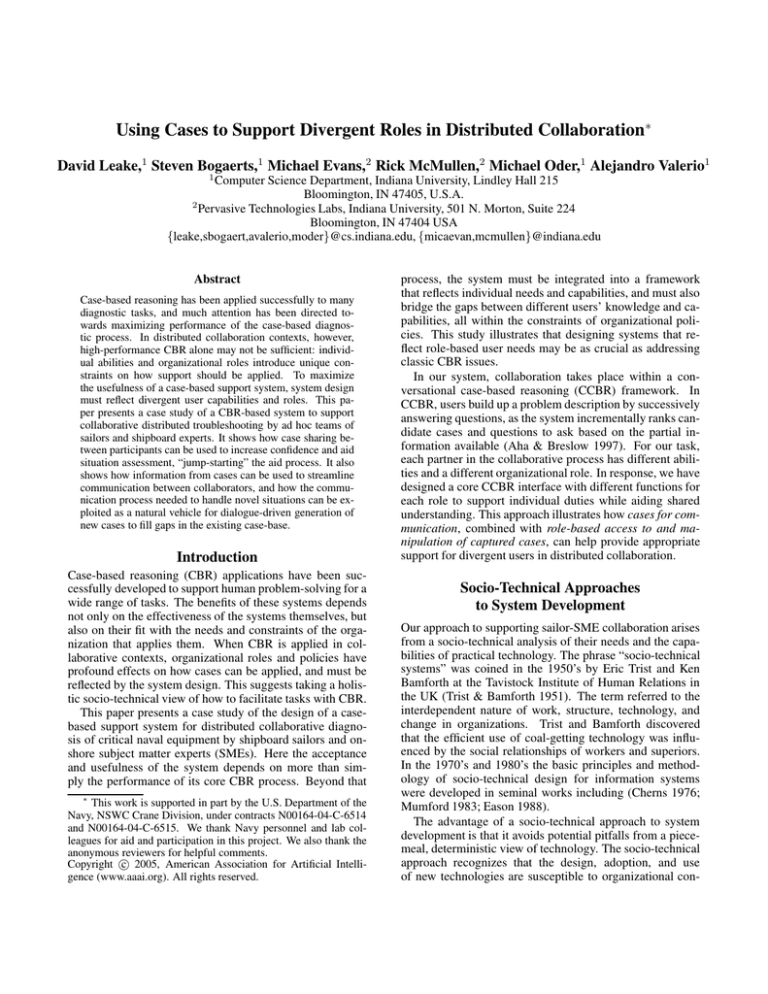
Using Cases to Support Divergent Roles in Distributed Collaboration∗
David Leake,1 Steven Bogaerts,1 Michael Evans,2 Rick McMullen,2 Michael Oder,1 Alejandro Valerio1
Computer Science Department, Indiana University, Lindley Hall 215
Bloomington, IN 47405, U.S.A.
2
Pervasive Technologies Labs, Indiana University, 501 N. Morton, Suite 224
Bloomington, IN 47404 USA
{leake,sbogaert,avalerio,moder}@cs.indiana.edu, {micaevan,mcmullen}@indiana.edu
1
Abstract
Case-based reasoning has been applied successfully to many
diagnostic tasks, and much attention has been directed towards maximizing performance of the case-based diagnostic process. In distributed collaboration contexts, however,
high-performance CBR alone may not be sufficient: individual abilities and organizational roles introduce unique constraints on how support should be applied. To maximize
the usefulness of a case-based support system, system design
must reflect divergent user capabilities and roles. This paper presents a case study of a CBR-based system to support
collaborative distributed troubleshooting by ad hoc teams of
sailors and shipboard experts. It shows how case sharing between participants can be used to increase confidence and aid
situation assessment, “jump-starting” the aid process. It also
shows how information from cases can be used to streamline
communication between collaborators, and how the communication process needed to handle novel situations can be exploited as a natural vehicle for dialogue-driven generation of
new cases to fill gaps in the existing case-base.
Introduction
Case-based reasoning (CBR) applications have been successfully developed to support human problem-solving for a
wide range of tasks. The benefits of these systems depends
not only on the effectiveness of the systems themselves, but
also on their fit with the needs and constraints of the organization that applies them. When CBR is applied in collaborative contexts, organizational roles and policies have
profound effects on how cases can be applied, and must be
reflected by the system design. This suggests taking a holistic socio-technical view of how to facilitate tasks with CBR.
This paper presents a case study of the design of a casebased support system for distributed collaborative diagnosis of critical naval equipment by shipboard sailors and onshore subject matter experts (SMEs). Here the acceptance
and usefulness of the system depends on more than simply the performance of its core CBR process. Beyond that
This work is supported in part by the U.S. Department of the
Navy, NSWC Crane Division, under contracts N00164-04-C-6514
and N00164-04-C-6515. We thank Navy personnel and lab colleagues for aid and participation in this project. We also thank the
anonymous reviewers for helpful comments.
c 2005, American Association for Artificial IntelliCopyright gence (www.aaai.org). All rights reserved.
∗
process, the system must be integrated into a framework
that reflects individual needs and capabilities, and must also
bridge the gaps between different users’ knowledge and capabilities, all within the constraints of organizational policies. This study illustrates that designing systems that reflect role-based user needs may be as crucial as addressing
classic CBR issues.
In our system, collaboration takes place within a conversational case-based reasoning (CCBR) framework. In
CCBR, users build up a problem description by successively
answering questions, as the system incrementally ranks candidate cases and questions to ask based on the partial information available (Aha & Breslow 1997). For our task,
each partner in the collaborative process has different abilities and a different organizational role. In response, we have
designed a core CCBR interface with different functions for
each role to support individual duties while aiding shared
understanding. This approach illustrates how cases for communication, combined with role-based access to and manipulation of captured cases, can help provide appropriate
support for divergent users in distributed collaboration.
Socio-Technical Approaches
to System Development
Our approach to supporting sailor-SME collaboration arises
from a socio-technical analysis of their needs and the capabilities of practical technology. The phrase “socio-technical
systems” was coined in the 1950’s by Eric Trist and Ken
Bamforth at the Tavistock Institute of Human Relations in
the UK (Trist & Bamforth 1951). The term referred to the
interdependent nature of work, structure, technology, and
change in organizations. Trist and Bamforth discovered
that the efficient use of coal-getting technology was influenced by the social relationships of workers and superiors.
In the 1970’s and 1980’s the basic principles and methodology of socio-technical design for information systems
were developed in seminal works including (Cherns 1976;
Mumford 1983; Eason 1988).
The advantage of a socio-technical approach to system
development is that it avoids potential pitfalls from a piecemeal, deterministic view of technology. The socio-technical
approach recognizes that the design, adoption, and use
of new technologies are susceptible to organizational con-
straints. Following this approach, to develop a CBR system
for naval technicians we examined three types of organizational features: strategy, structure, and task complexity.
Strategically, the U.S. Navy intends to leverage expertise
by developing advanced information technologies to encourage knowledge generation and distribution. Consequently,
our system has been designed to ensure that users are able to
communicate and access a rich store of troubleshooting experience to which they may add (Evans 2004). Structurally,
the Navy has organized its troubleshooting units in an ad hoc
fashion. Consequently, our system must be flexible enough
to serve users from a variety of functional contexts and levels of expertise. Finally, the task of troubleshooting at a distance is both unpredictable and hard to codify. This entails
that the system supplement codified knowledge with support
for use of tacit knowledge (e.g., encouraging remindings and
associations), the latter being especially useful in times of
improvisation and innovation.
The Collaborative Distributed
Troubleshooting Task
In current U.S. Navy practice, non-expert sailors troubleshoot complex electronic systems by relying on standard
diagnostic flowcharts and technical manuals to isolate one or
more detected faults. This prescribed troubleshooting process is most effective for documented faults. When standardized methods and support materials are exhausted, the
attending sailor contacts a remote shore-based SME for assistance. For this interaction, sailor(s) and SME(s) often
have only basic media support, in the form of email, chat,
and paper documents. In order to resolve a problem successfully: 1) the SME must request a detailed account of all
actions taken prior to the request for technical assistance; 2)
the sailor must convey any unique aspects of the operating
environment, including recent upgrades and climatic conditions, 3) based on data received, the SME must diagnose the
problem and prescribe corrective actions; and 4) the sailor
must correctly perform the corrective actions and either confirm successful resolution of fault(s) or request further assistance (Evans 2004).
Plans for significant staffing reductions in the U.S. Navy,
combined with increasingly complex shipboard systems,
loss of experience due to job turnover and retirement, and
the difficulty and expense of extensive training, make shipboard automation a major priority. The success of CCBR
in diagnostic applications (see (Watson 1997) for samples)
and the comparative simplicity of leveraging experience and
learning in CBR systems suggested applying these methods
to the diagnosis of shipboard systems.
Challenges for Shaping Case-Based Support to
Fit Navy Policies
In conversational CBR diagnosis systems, cases for
previously-diagnosed problems suggest questions to ask a
user, to guide retrieval of similar prior cases suggesting diagnoses for the current problem. This appears to provide
a natural replacement for the sailor’s flowchart-following
process, and initial efforts to build a CCBR system for this
task were encouraging, both from the viewpoint of technical
promise and for reactions of potential end users.
Unfortunately, when a prototype system was demonstrated, two problems arose. First, the actors in the Navy
process are bound to act in accordance to institutional policies. In particular, sailors are required to follow standard
diagnostic flowcharts; they do not have the authority to skip
portions of the standard flowcharts as dictated by the choice
of questions in CCBR. Second, learning from a sailor’s diagnostic experiences is problematic as well. When the systems being diagnosed play a vital role in the ship’s mission,
confidence in system advice is crucial. If sailor cases were
captured and reused directly, the accuracy of cases could not
be assured due to the sailors’ lack of expertise in and authority for solution certification. Thus simply providing the
sailor with case-based support was impossible.
In the naval process, only the SME is empowered to
go beyond the standard troubleshooting procedures. Thus
CCBR support can be provided to the SME. We decided to
study how to maximize support for both the sailor and SME,
in the context of their interaction. Although the sailor is
not allowed to use case-based reasoning directly, cases can
still support his or her role by aiding the sailor’s capture and
communication of information, in addition to the more traditional CBR tasks provided to the SME, as discussed in the
following section.
Opportunities for Supporting Collaborative
Distributed Troubleshooting
A first step towards developing support for a collaboration is
to examine the needs of the individuals involved. Previous
studies note that ad hoc teams are susceptible to a number
of difficulties arising from interaction problems and other
limitations. In our task context, these difficulties include:
Forgetfulness: Diagnostic actions performed by the sailor
may be forgotten and not conveyed from sailor to SME.
Insufficient Knowledge: Sailors may need additional support to carry out tasks or describe the problem effectively.
Unfamiliarity With Personnel: The SME may lack a clear
picture of the sailor’s level of understanding.
Lack Of Confidence: The SME does not know what the
sailor has truly done, only what the sailor says he or she
has done. Thus, it is often necessary for the SME to ask
the sailor to repeat steps.
Communication Breaks: External events may impose delays in the interaction, making it difficult to maintain mutual understanding.
These difficulties can be summarized as reflecting a communication gap between the sailor and SME. For example,
in own studies a shore-based SME of seventeen years’ service reported:
”I’ll be honest: [remote troubleshooting is] really difficult. But, the key is the technician on the other end, you
know... I mean you can have all the documentation in
the world and if you don’t have an experienced tech on
the other end of the line, you can do Distance Support
until you’re blue in the face. But, if he can’t describe
the problem to you [then it will inevitably remain unresolved].”
Thus bridging the communication gap between sailor and
SME is crucial. We established the goal of providing an integrated CCBR interface, following institutionally-sanctioned
practice, to meet this need.
Our approach centers on using cases as a shared basis for
collaboration, with information added to or accessed from
cases in light of individual participants’ roles. A key contribution is that the use of cases is not restricted to a single
centralized problem-solving system. Instead, cases are used
as a vehicle for knowledge sharing between users, with aspects of CBR processing exploited when helpful, and case
information used in different ways at different parts of the
process.
System assistance centers on four phases of the collaborative distributed troubleshooting process, each one supported
by different methods, as listed below. For each, we summarize the goals of the assistance and the methods we selected
to address them. The specific communication difficulties
that these address are listed in parentheses. In the following section we describe the resulting process and support in
more detail.
During initial sailor troubleshooting: Aid the sailor following standard procedures (insufficient knowledge) and
automatically log actions (sailor forgetfulness, lack of
confidence).
Method: Present diagnostic questions in a CCBR-like interface, capturing responses to form an initial case.
During establishment of sailor-SME contact: Aid initial
communication(forgetfulness), SME situation assessment
and confidence in the result (lack of confidence), and continuity over multiple episodes (communications breaks)
Method: When a sailor initiates contact, automatically
transfer accumulated case to the SME, giving immediate
and accurate knowledge about the steps the sailor traced.
This case remains accessible as a reference whenever contact is reinitiated after an interruption.
During collaborative troubleshooting:
• Aid the SME’s diagnostic task.
Method: Use data from the sailor’s case as retrieval
cues to suggest possible cases for the SME to pursue.
• Streamline further communication.
Method: Allow the SME to select questions from existing cases to dispatch to the sailor, for presentation
in the sailor’s conversational interface, and transmit responses while recording them as additions to the sailor
case.
During knowledge update: Aid the SME in capturing useful knowledge.
Method: At the end of the diagnostic process, present the
new case, including SME-selected additional questions,
to be vetted by the SME.
A Detailed Walkthrough of System Use
In the implemented system, the sailor and SME interact with
the system according to the following process:
Standard Troubleshooting: When a fault occurs for a
piece of equipment, the sailor is dispatched and performs
standard troubleshooting as guided by the system.
• The system selects questions to present to the sailor one
at a time based on standard troubleshooting flowcharts.
• For each question, the sailor is presented with related resources to assist in answering the question (e.g.
schematics, additional directions).
• The sailor provides answers to these questions. These
answers are added automatically to the initial problem
description of the case under development for this troubleshooting session, for later storage as a new case.
• Often, after a series of questions, the flowchart will dictate a diagnosis and corrective action.
Establishment of Contact with SME: If the sailor exhausts standard procedures, the SME is contacted.
• The preliminary case (problem description), based on
the actions of the sailor so far, is presented to the SME.
Similar cases are automatically retrieved from the case
base.
• The SME may optionally suggest a diagnosis and corrective action. These could come from either a similar
case or personal experience.
• If the SME is not prepared to suggest a diagnosis and
corrective action, additional questions may be prepared
for the sailor in order to further assess the problem.
These questions can come from similar cases, the question collection at large, or any new questions the SME
wishes to define based on personal experience.
• The SME sends a response to the sailor, containing either the diagnosis and corrective action, or further questions.
Sailor Response To SME: The sailor receives the SME’s
advice.
• If the SME sent additional questions, the sailor answers
them, within the same interface that the standard troubleshooting procedures were done. These answers are
added to the current case.
• If the SME sent a diagnosis and corrective action, the
sailor performs the corrective action and checks if the
fault has been resolved. If the fault has not been resolved, the failed diagnosis and corrective action are
added to the case’s description. If the fault has been resolved, this result is prepared for communication to the
SME.
• The sailor’s answers, or the results of the corrective action, are sent back to the SME in the form of the case.
SME Receives Response: The SME receives the sailor’s
response to the previously sent advice.
• If questions were answered, or a corrective action
failed, the SME continues troubleshooting as in the Initial Contact with SME step above.
• If the corrective action succeeded, the SME has the option of indicating the diagnosis and action as the case
solution. The case may be further edited by the SME,
removing features deemed irrelevant for the problem
description. The case can then be added to the case
base for use in future problem-solving episodes.
Interface Design
To support the above processes, sailor and SME interfaces
must enable multiple types of interactions and use of multiple types of information. Both the sailor and SME interfaces
support system question-asking and answer capture, following the standard CCBR model, but how these are used and
the additional capabilities they provide reflect specific user
roles.
Sailor Interface The sailor interface contains the following
components:
• Conversational flowchart guidance (see figure 1a.): The
sailor answers questions, either from standard procedures or from those suggested by the SME. The sailor
can view the problem description up to this point as
well as select resources related to the current question
to be displayed.
• Conversational CBR: We have implemented CCBR in
a version of this interface, to demonstrate that if direct
CCBR support were allowed for this “first-line” troubleshooter, it could be seamlessly integrated with the
flowchart process by retrieving cases, based on accumulated answers to questions, if the end of a flowchart
is reached without a diagnosis. This would enable deflecting SME contacts for situations in which CCBR is
sufficient. However, we expect institutional constraints
to preclude its inclusion in the fielded system.
• Resource Search: Flowchart steps may be annotated
with links to resources, and the sailor may do a free-text
search through on-line resources (e.g., technical documents and “business cards” for relevant personnel) for
additional assistance.
SME Interface The SME interface is divided into the following:
• Current Tech Assist: The view of the current problem
(tech assist), any notes entered by the sailor or SME,
and the solution, if one has been reached.
• Related Tech Assists: (see figure 1b.) A ranked list of
cases similar to the current problem.
Details of any case may be viewed, with a color-coded
comparison of features matching and mismatching the
current problem. Any question answered in a case may
be queued to be sent to the sailor.
The bottom portion of this screen lists each feature in
a specific case selected from the list, color-coded—
Green features have the same values as their counterparts in the current case, while features marked in red
have values that do not match. The white features represent questions that have not yet been asked in the current troubleshooting session. The user may then select
one of these features and add it to a queue of questions
to be sent to the sailor.
For questions that the SME would like to ask that are
not part of prior cases, the SME may browse the collection of questions, and also define entirely new ones.
Additional unstructured communications become annotations of the case, potentially available for future
examination or analysis.
• Continue Troubleshooting: A viewer for available
questions and questions queued to be sent to the sailor.
Additional questions may be added to the queue.
• Suggest Resolution: An interface to allow the SME to
suggest a diagnosis and corrective action for the current
problem.
After problem resolution, the SME can access an additional
interface to vet cases, reviewing questions answered by the
sailor, selecting questions to retain/discard by clicking (e.g.,
to delete unfruitful paths), and choosing whether to store the
cases.
Reflecting Divergent Needs
The implemented approach addresses the sailor and SME’s
divergent needs in many ways:
Sailor diagnostic support: The system directly supports
the sailor’s routine tasks by automatically guiding the
sailor through a flowchart and making technical documents available as needed.
Knowledge capture for future sailor diagnostic support:
The system supports sailor organization/grouping of accessed documents, to automatically make useful
collections available in the future.
Information capture from sailor, for use by SME: The
system captures each sailor response, in order to provide
a trustworthy record of the sailor’s task context. In this
way, case generation relieves the sailor of the need to
record the troubleshooting sequence and aids the sailor’s
role of being the “eyes and ears” for the SME.
Communication of context sailor → SME: When standard flowchart-based diagnostic procedures are completed without problem resolution, the system provides
the complete case record to the SME. In this way, the
case is used to alleviate the need for the sailor to act as a
reporter.
SME diagnostic support: The system provides the SME
with standard CCBR support for diagnosis.
Communication SME → sailor: The system streamlines
SME information-gathering by enabling the SME to select questions from existing cases—either from those
highly ranked by the CBR system, or from others the
SME may choose due to his or her own experience and
knowledge—to send to the sailor.
Support for knowledge capture for SME use: After
problem resolution, the system supports analysis of
the case record by the SME, to select key diagnostic
features to add to the case base, distilling and distributing
knowledge.
(a) Portion of interface for supporting sailor.
(b) Interface for supporting SME.
Figure 1: . Interfaces for supporting sailor and SME reasoning and communication.
Perspective
Conversational case-based reasoning has been extensively
applied to diagnostic help desks. Heider (1996) describes
the application of CBR and induction in a system that constructs fault trees, similar to the fault trees taken as the start-
ing point for our diagnosis task. The APPLICUS project
applied CBR to robot maintenance (Bartsch-Spörl 1997), in
circumstances similar to those of our project, including distance support under organizational constraints. Both of the
above systems stem from the INRECA projects (Bergmann
2001), which illuminated (among many other points) the
importance of knowledge refinement by an expert. In our
project, refinement is accomplished by the SME’s verification and final selection of attributes to be stored with a case.
Our work emphasizes the role of cases in supporting a
broader process, in light of institutional factors that constrain
the application of CCBR technology. The lessons of this
project relate to a number of topics of interest for CBR:
• The possibility of, potential need for, and value of integrating limited facets of CBR into parts of the work process for which full CBR is not allowed, as done in the
sailor’s CCBR-style interface and sailor experience capture.
• That case building by automatic user tracking can aid a
natural transfer of problems between collaborating participants, as shown here aiding situation assessment by the
SME and increasing SME confidence.
• That the roles of the expert and the CCBR system should
be cooperative, as illustrated here with the SME provided
support to easily merge case-provided knowledge with his
or her own knowledge, supported by capture and editing
for these new cases.
• That a natural approach to case acquisition is to track
questions from a human diagnostic dialogue—and that the
use of stored questions from prior cases to support the dialogue can facilitate that process. This can make building
of new cases an extension/revision process starting from
near-miss cases.
A number of issues remain for future study. For example,
the current design relies on the SME to vet cases, but does
not address possible conflicts between different SMEs’ judgments of important features, etc. Likewise, as SMEs add
features, tools are needed to help standardize their feature
choices, to make sure that related cases remain comparable. Such consistency issues have been previously identified
in case-base maintenance research (e.g., (Racine & Yang
1996)), as have additional issues in managing the development of a case base and CBR system as a whole (Leake et
al. 2001). We are examining the application and extension
of methods to address such problems.
Another class of problems that we identified remains to
be addressed as well: The problems which may arise due
to lack of familiarity between participants in an interaction.
We anticipate that by various methods, such as examining
stored training records or assessing the sailor’s needs to consult additional resources, it will be possible for the system to
present the SME with not only a problem case, but also with
information about the sailor with whom the SME is communicating. How to generate this information, and how to help
the SME tailor responses and suggest appropriate resources
to aid the sailor, is a future area for our research.
Conclusion
This paper has described a system to support knowledge
capture, transfer, and sharing as it provides a vehicle for
communication between sailors and SMEs. The system captures and conveys information about previous diagnoses,
supporting the SME with specific case information from
the sailor, and with a case-based reasoning (CBR) system
to provide suggestions. When existing cases are on-point,
the SME can satisfy institutional confidence requirements
by simply certifying the solution; when existing cases are
not, they nevertheless may suggest useful questions. This
facilitates the SME’s own question-asking process—a process that is automatically used to build new cases for the
future. Informal feedback from potential users has been positive, and we have developed plans for a formal evaluation
to quantitatively assess the system benefits. We believe that
systems aimed at case-based support for collaboration, reflecting overarching institutional constraints, are a promising avenue for added acceptance for real-world CBR.
References
Aha, D., and Breslow, L. 1997. Refining conversational
case libraries. In Proceedings of the Second International
Conference on Case-Based Reasoning, 267–278. Berlin:
Springer Verlag.
Bartsch-Spörl, B. 1997. How to introduce CBR applications in customer support. In Proceedings of the 5th German CBR Workshop.
Bergmann, R. 2001. Highlights of the european INRECA
projects. In Proceedings of the Fourth International Conference on Case-Based Reasoning, volume LNCS 2080, 1–
15. Berlin: Springer-Verlag.
Cherns, A. 1976. The principles of socio-technical design.
Human Relations 28(8):783–792.
Eason, K. 1988. Information technology and organisational change. London: Taylor and Francis.
Evans, M. 2004. Knowledge and Work in Context: A Case
of Distributed Troubleshooting Across Ship and Shore.
Ph.D. Dissertation, Indiana University.
Heider, R. 1996. Troubleshooting CFM 56-3 engines for
the Boeing 737 using CBR and data-mining. In Proceedings of the Third European Workshop on Case-Based Reasoning, volume LNCS 1168, 512–523. Berlin: SpringerVerlag.
Leake, D.; Smyth, B.; Wilson, D.; and Yang, Q., eds. 2001.
Maintaining Case-Based Reasoning Systems. Blackwell.
Special issue of Computational Intelligence, 17(2), 2001.
Mumford, E. 1983. Designing Human Systems. Manchester, UK: Manchester Business School Publications.
Racine, K., and Yang, Q. 1996. On the consistency management of large case bases: The case for validation. In
Proceedings of the AAAI-96 workshop on Verification and
Validation. Menlo Park, CA: AAAI Press.
Trist, E., and Bamforth, K. 1951. Social and psychological consequences of the Longwall method of coal-getting.
Human Relations 4:3–38.
Watson, I. 1997. Applying Case-Based Reasoning: Techniques for Enterprise Systems. San Mateo, CA: Morgan
Kaufmann.

